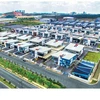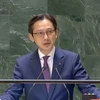Catastrophic flooding and crop losses in Thailand, the world's leading rice exporter, are raising concerns that another food crisis may be in the offing. Further disquieting is the possibility that the world may have already entered a new era where persistently high food prices are the “New Normal.”
In his article to Vietnam Plus, Iwan J. Azis, Head of the Asian Development Bank’s Office of Regional Economic Integration, said that at a time when policymakers are grappling with a host of thorny economic issues, the possibility may be unwelcome, but must not be ignored.
“Although volatility in commodity markets is nothing new, there are worrying signs that food price fluctuations are now taking place within a much higher band-with than ever before,” he said.
For Asia’s poor, who already spend 60 percent of their household budget on food, even the smallest fluctuation in food prices forces unenviable choices on where best to devote their scant resources. It means that those striving to escape poverty are less likely to do so, while millions more risk falling below the 1.25 USD a day poverty line.
The ADB estimates that a 10 percent rise in domestic food prices in developing Asia threatens to push an additional 64 million people in to poverty. With food price inflation in many emerging Asian economies averaging 11 percent in the first half of 2011 alone, the growing numbers of families facing the scourge of dire poverty is staggering.
Much of the sharp increase in the region’s food prices is due to production shortfalls caused by extreme weather events, such as droughts and floods, and subsequent export bans by some food producing countries. Growing appetites for grains, oil, seeds, sugar, and livestock in emerging economies like China and India are exerting further upward pressure on supply.
Additionally, Azis he stressed a growing trend of “financialising” commodities over the past decade, which has turned food into an important tradable asset class, like stocks, bonds, currencies, or real estate, and of course the weakness of the US dollar, in which most food commodities are denominated, as well as high oil prices, which raise costs at almost every step of the food supply chain.
With a “New Normal” of persistently high and volatile food prices here to stay, what are policymakers to do?
The ADB official said there are no easy solutions, but when faced with bouts of soaring food prices, governments must be both pragmatic and flexible.
According to Azis, tightening monetary policy, like raising interest rates, is a standard tool to combat inflation and cool economic overheating.
“It is a fairly ineffective tool if the inflationary pressure is supply-side, however, and relatively blunt if price movements are volatile. Rate hikes take months to show results, and if overblown can tighten the economic leash until it chokes growth, especially for small and medium businesses,” he said.
Inflation targeting is also of questionable value if the public does not view the measures as credible, he said, adding with food price inflation on the rise, social programmes that target the most vulnerable members of society from the effects of higher commodity prices can be used where budgets allow.
“This measure is less costly for the economy as a whole compared to tightening monetary policy.”
There are other levers policymakers can pull, including a broad range of supply-side policies that can reduce bottlenecks in commodity-based industries, improving access to global markets and increasing productivity. The further reduction of trade barriers between countries should be pursued through regional cooperation and other forums, he further said.
In large countries overall food supply may not be a problem, yet there are still serious problems in some sub-national regions. In such instances, improved distribution channels to ensure a more reliable supply of commodities to remote and isolated areas can play a critical role.
Taken together, it is clear that a globalised approach is needed to effectively address food price inflation. Countries normally address their own needs as they see best, but the demands of rapid economic growth and development increasingly cross borders.
“While acting nationally, policymakers will need to think globally and coordinate regionally. Only then can we be assured enough resources will be available to keep growing appetites satisfied at reasonable costs,” he affirmed./.



















